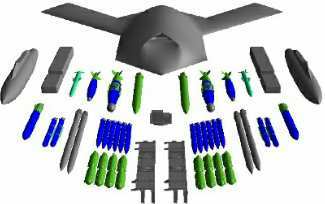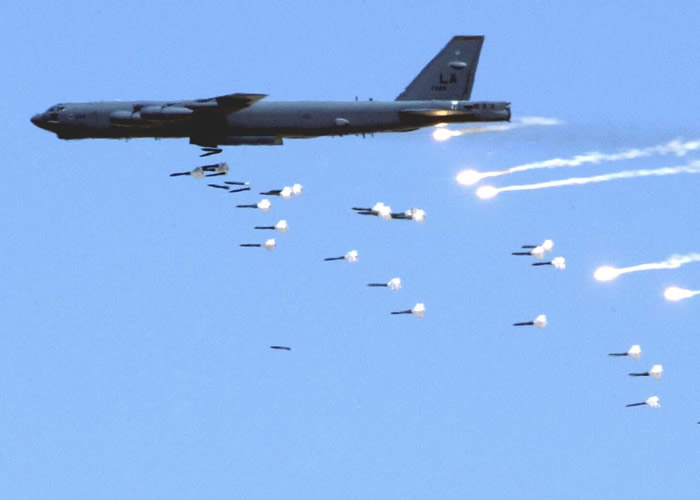It looks like you're using an Ad Blocker.
Please white-list or disable AboveTopSecret.com in your ad-blocking tool.
Thank you.
Some features of ATS will be disabled while you continue to use an ad-blocker.
6
share:
Killer Swarms: The New Generation
No longer will we need pilots to fly those war planes. All we need to do is recruit some gamer geeks, stick them in a room somewhere and give them a joy stick...
Then they can control SWARMS of these killer UAV's
defensetech.org...
X-45C weapons capability
www.globalsecurity.org...

I suppose if the PTB wanted to use them against us, they wouldn't have to be concerned about pilots who wouldn't turn on their own people..
But already Predators are patrolling the CANADIAN Border
Predator drones patrolling Canada-U.S. border
www.nationalpost.com...
Good old Homeland Security... making sure those crazy Candians don't swarm over the border
:shk:
Unmanned plane patrolling stretch of Canada-U.S. border
www.montrealgazette.com...
Predator drone now patrols 900-mile stretch of Canada-US border
Jan 27, 2011
www.digitaljournal.com...
And here I though Canada was an Ally? What about the southern border where the CIA..... errrr drug cartels are smuggling in drugs and the illegal immigrant flow is a tsunami?
Edit to add my favorite picture

No longer will we need pilots to fly those war planes. All we need to do is recruit some gamer geeks, stick them in a room somewhere and give them a joy stick...
Then they can control SWARMS of these killer UAV's
Nature is way ahead of us here. A flock of a thousand starlings can maneuver together with ease, changing flight plans from moment to moment, and without any central control. The methods they use are remarkably subtle and effective, and researchers are borrowing these from nature to enable multiple UAVs to operate in the same airspace without the risk of collision. Read more: defensetech.org... Defense.org
defensetech.org...
X-45C weapons capability
www.globalsecurity.org...

I suppose if the PTB wanted to use them against us, they wouldn't have to be concerned about pilots who wouldn't turn on their own people..
But already Predators are patrolling the CANADIAN Border
Predator drones patrolling Canada-U.S. border
Another stretch of the Canada-U.S. border is now being patrolled by an unmanned Predator B drone, another step in Homeland Security’s plan to have the planes eventually flying over the longest undefended border in the world.
The U.S. Customs and Border Protection’s office of Air and Marine have announced that a Predator drone plane has begun flights out of Fort Drum, N.Y., at the eastern end of Lake Ontario.
The plane is being deployed to conduct surveillance operations along the maritime border between Ontario and New York state in Lake Ontario and the St. Lawrence Seaway and the border at the Niagara River.
Under Operation Empire Shield, the entire Canada-U.S. border will be eventually be subject to such flights by Predator drone planes.
www.nationalpost.com...
Good old Homeland Security... making sure those crazy Candians don't swarm over the border
:shk:
Unmanned plane patrolling stretch of Canada-U.S. border
www.montrealgazette.com...
Predator drone now patrols 900-mile stretch of Canada-US border
Jan 27, 2011
www.digitaljournal.com...
And here I though Canada was an Ally? What about the southern border where the CIA..... errrr drug cartels are smuggling in drugs and the illegal immigrant flow is a tsunami?
Edit to add my favorite picture

edit on 11-2-2011 by zorgon because: Classified
reply to post by zorgon
Whoa, looks like a gamers wet dream..
Quite a bit of firepower in them things..
As for the Drone patrols..
A few thread posters say they may make great target practice in the off season..
Whoa, looks like a gamers wet dream..
Quite a bit of firepower in them things..
As for the Drone patrols..
A few thread posters say they may make great target practice in the off season..
DARPA "stage II" UCAV ARSENAL
x-45A Boeing
This paper has us still fighting insurgents in the Middle East into 2025
ACCELERATING THE KILL CHAIN VIA FUTURE UNMANNED AIRCRAFT
"AFIT UAV Swarm Mission Planning and Simulation System" (Air. University, 2006),
www.au.af.mil...
0602211A - ARMY RDT&E BUDGET ITEM JUSTIFICATION (R-2 Exhibit)
design of UAV "swarm" control for vehicle/mission equipment/flight management architectures. Evaluate system performance/effectiveness/risk. ...
Fiscal year 2004
www.dtic.mil...
Fiscal year 2005
www.dtic.mil...
No guarantee these links work outside the USA
x-45A Boeing
This paper has us still fighting insurgents in the Middle East into 2025
ACCELERATING THE KILL CHAIN VIA FUTURE UNMANNED AIRCRAFT
"AFIT UAV Swarm Mission Planning and Simulation System" (Air. University, 2006),
www.au.af.mil...
0602211A - ARMY RDT&E BUDGET ITEM JUSTIFICATION (R-2 Exhibit)
design of UAV "swarm" control for vehicle/mission equipment/flight management architectures. Evaluate system performance/effectiveness/risk. ...
Fiscal year 2004
www.dtic.mil...
Fiscal year 2005
www.dtic.mil...
No guarantee these links work outside the USA
how about flying a modified B-1 to serve as control center/mothership for these swarms, what do you guys think of the idea?
The Houston Police Department wasn't planning on announcing its unmanned aerial vehicle (UAV) test program. But when a local news team from KPRC caught the drone on camera on Nov. 16, the department reluctantly released some information, however skimpy. The FAA-approved test took place within a 2-mile radius 45 miles west of Houston, and involved a single fixed-wing drone. The aircraft was remote-controlled from the ground by operators from Washington-based Insitu, Inc., which had also built the UAV.
Now, Insitu has confirmed that the model used in the test was the Insight, a 44-pound, long-endurance drone with a 10.2-ft. wingspan--one that's currently used by both the Marines and the Navy in Iraq.
The Insight can be equipped with a standard electro-optical camera, as well as an infrared camera, mounted on an inertially stabilized turret. This is a straightforward recon drone, able to operate without a runway, using Insitu's SuperWedge Launcher for takeoffs and the company's Skyhook Retrieval System for landings. The Insight aircraft used by the Navy--marketed as ScanEagles--are capable of autonomous flight, but it's not clear whether those functions were part of the recent test in Texas.
Popular Mechanics
No munitions on this one (yet).
edit on 12-2-2011 by timewalker because: linky
new topics
-
Welp...Happy New Year!!
General Chit Chat: 34 minutes ago -
Vehicle Strikes people in New Orleans
Mainstream News: 2 hours ago -
The Hand that Rocks the Cradle - Labour Plans “diversities of our society” Curriculum Change
Regional Politics: 2 hours ago -
SCOTUS Chief Justice JOHN ROBERTS Ends 2024 Describing His Fears for Safety of U.S. Judges.
Above Politics: 10 hours ago
top topics
-
How we've changed in 100 years
Ancient & Lost Civilizations: 17 hours ago, 8 flags -
Vehicle Strikes people in New Orleans
Mainstream News: 2 hours ago, 6 flags -
SCOTUS Chief Justice JOHN ROBERTS Ends 2024 Describing His Fears for Safety of U.S. Judges.
Above Politics: 10 hours ago, 3 flags -
The Hand that Rocks the Cradle - Labour Plans “diversities of our society” Curriculum Change
Regional Politics: 2 hours ago, 1 flags -
Welp...Happy New Year!!
General Chit Chat: 34 minutes ago, 1 flags
6




